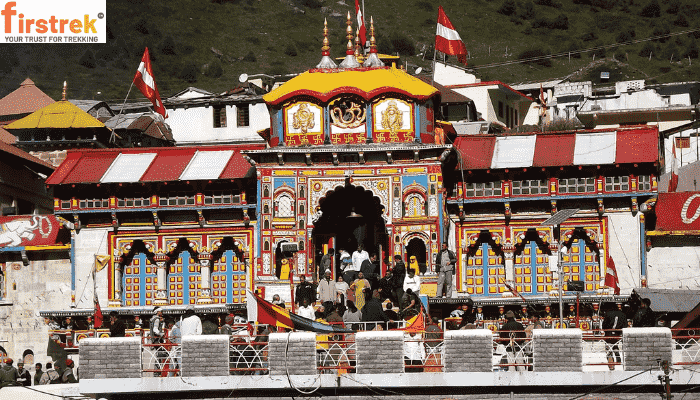
Badrinath Dham Weather Updates, Today, This Week & Next 3 Weeks
Nestled amid the majestic Garhwal Himalayas, Badrinath—a revered pilgrimage site—is subject to diverse weather patterns that significantly influence both its serene beauty and the journey of thousands of pilgrims and travellers each year. Understanding the intricate variations in Badrinath weather, including temperature fluctuations, precipitation levels, and other climatic changes, is paramount for planning any trip to this sacred destination.
With the climate ranging from cold winters to mildly warm summers, the temperature in Badrinath and overall weather conditions play a crucial role in determining the best times for visitation and the necessary preparations for a safe and fulfilling journey.
Table of Contents
Badrinath Weather

This article offers a comprehensive guide to the Badrinath weather today, including a detailed forecast for the upcoming week and an extended outlook for the next three weeks. It delves into the specifics of Badrinath temperature and other critical weather considerations, such as the potential for rainfall, snow, and temperature extremes that could impact travel plans.
Additionally, the piece provides an advisory for visitors, highlighting essential tips and recommendations for adapting to the weather of Badrinath, ensuring that pilgrims and tourists alike can make the most of their visit. With an engaging and informative approach, this discussion aims to equip travellers with the knowledge they need to navigate the dynamic and sometimes challenging climate, enhancing their spiritual and adventurous experiences in this divine locale.
Badrinath Dham Weather Today
This sacred site, dedicated to Lord Vishnu, attracts thousands of devotees and tourists annually. However, planning a visit to Badrinath requires careful consideration of the weather, as the region’s climate can significantly influence travel plans and pilgrimage experiences. Today, we bring you the latest update on the weather, helping you prepare for a safe and spiritually fulfilling journey.
Early Morning Weather
The day in Badrinath starts with a partly sunny morning, registering temperatures around 15°C, which feels like 20°F due to the RealFeel® metric. Wind speeds are mild at 3 mph, with gusts reaching 9 mph. The air quality remains excellent, making the early hours ideal for pilgrims and visitors to start their activities.
Afternoon Weather Trends
As the day progresses, the Badrinath weather slightly increases, peaking at 18°C by mid-afternoon. However, the chances of precipitation remain low throughout the day, with humidity levels hovering around 7% during these hours. Visitors can expect consistent weather conditions with only minor fluctuations, ensuring a pleasant experience for sightseeing and other outdoor activities.
Night Weather
The evening brings a transition to cooler conditions as the temperature gradually decreases to a low of 10 °C. The sky remains partly cloudy, maintaining the low likelihood of rain that persists throughout the night. This cooler night weather is typical for Badrinath during this time of the year, suggesting that visitors should prepare with appropriate clothing for nighttime temperatures.
Weather Forecast for This Week

It is critical to recognize the distinctive climatic patterns that Badrinath weather is known for when examining the weather forecast for this coming week.
Daily Temperature Range
Throughout the week, the weather in Badrinath will fluctuate moderately. The week starts with a temperature of 65°F, gradually peaking at 79°F by the end of the week. Minimum temperatures will dip to around 50°F, providing cool relief during the night hours.
Rain Chances
Rainfall is expected intermittently throughout the week. The likelihood of rain increases as the week progresses, with a significant chance of precipitation towards the weekend. Notably, on Monday, the area may receive up to 7.99 mm of rainfall, marking it as the day with the highest expected precipitation.
Wind Conditions
Wind speeds will vary, with the windiest day predicted to have speeds reaching up to 9 mph. This will occur on Monday, coinciding with the highest rainfall, which may lead to cooler and brisker conditions overall.
Detailed Forecast for the Next 3 Weeks
As the summer season peaks, understanding the weather patterns over the coming weeks becomes essential for both the devotees planning their pilgrimage and the tourists eager to explore the region’s natural beauty. Consequently, a detailed weather forecast for the next three weeks is indispensable for ensuring a safe and enjoyable trip.
Week 1: General Trends
The first week of the forecast period in Badrinath weather shows a trend of gradually increasing temperatures, starting from a low of 56°F and reaching up to 64°F. Nighttime temperatures will hover around 33°F. Visitors should prepare for cooler evenings and mornings, with daytime warming suitable for outdoor activities.
First and foremost, the current weather trends indicate a mix of clear skies and intermittent rain showers, which is typical for this time of year. The forecast predicts mild temperatures during the day, making it pleasant for outdoor activities. However, the evenings and nights are expected to be significantly cooler, prompting visitors to pack appropriate clothing to stay warm. As always, the weather in the Himalayas can be unpredictable, and sudden changes are not uncommon. Therefore, keeping a close eye on the daily weather updates will be crucial for those planning treks or other outdoor excursions.
Week 2: Weather Highlights
During the second week, Badrinath weather is expected to see a slight rise in temperatures, with highs potentially reaching 67°F and lows maintaining at around 36°F. This period may also bring occasional rainfall, so carrying waterproof gear is advisable for those planning to venture outdoors.
Transitioning into the specifics, the first week promises predominantly sunny days with occasional clouds. This period is ideal for sightseeing and visiting the Badrinath Temple, as the weather will be relatively stable. Moving into the second week, there is an anticipated increase in cloud cover, leading to sporadic rain showers. This shift might affect travel plans slightly, but it also offers a unique opportunity to witness the lush, rain-washed landscape that is characteristic of the monsoon season in this region.
Week 3: Expected Conditions
The third week anticipates a continuation of mild Badrinath weather, with daytime temperatures peaking at 69°F. However, the minimum temperatures are likely to drop slightly to around 34°F. This week might experience less precipitation compared to the previous weeks, providing clearer skies and more opportunities for sightseeing.
By the third week, the weather pattern is expected to become more dynamic. Increased precipitation is likely, which could lead to slippery paths and possible travel delays. Despite these challenges, the verdant surroundings and the mist-covered mountains provide an enchanting backdrop for visitors. Travelers are advised to carry waterproof gear and to check local advisories regularly to avoid any disruptions.
The next three weeks of Badrinath weather will present a blend of clear and rainy days, with temperatures ranging from mild to cool. Adequate preparation and flexibility in travel plans will be key to making the most of the trip. By staying informed about the latest weather conditions, visitors can ensure a memorable and safe experience in this spiritually and naturally enriching destination.
The best time to visit Badrinath Dham

While the spiritual significance of Badrinath Dham is undisputed, planning a trip to this divine destination requires careful consideration of several factors, especially the weather. Understanding the nuances of the weather is crucial to ensuring a fulfilling and safe journey.
| Season of Travel | Temperature | Time |
| May to June | 15 °C to 25 °C | Summer |
| July to August | 12 °C to 20 °C | Monsoon |
| September to October | 8 °C to 15 °C | Autumn |
The Importance of Badrinath Dham Spiritually
Before delving into the ideal time to visit, it is essential to appreciate the spiritual essence of Badrinath Dham. Dedicated to Lord Vishnu, Badrinath Temple is one of the four Char Dham pilgrimage sites in India, which also include Yamunotri, Gangotri, and Kedarnath. These sites are collectively known as the Char Dham Yatra, a journey that devout Hindus aspire to undertake at least once in their lifetime. Badrinath is believed to be the place where Lord Vishnu meditated under the Badri tree, providing salvation to his devotees.
Badrinath Weather: A Seasonal Guide
Badrinath weather plays a pivotal role in determining the best time to visit. The region experiences a typical Himalayan climate with distinct seasonal variations. Therefore, understanding the weather patterns throughout the year can help pilgrims and tourists plan their visit more effectively.
Summer (May to June)
The summer season, extending from May to June, is considered the best time to visit Badrinath Dham. During these months, the weather is pleasantly cool, with temperatures ranging from 10°C to 18°C. The snow begins to melt, making the journey to the temple accessible and relatively comfortable. The temple doors (Kapat) open to devotees around April or May, marking the beginning of the pilgrimage season. The lush green surroundings, blooming flowers, and serene ambience create a perfect backdrop for spiritual reflection and devotion. Additionally, the summer season is ideal for sightseeing and exploring nearby attractions like Tapt Kund, Neelkanth Peak, and Mana Village.
Monsoon (July to September)
Transitioning into the monsoon season, which lasts from July to September, Badrinath weather becomes quite challenging. The region receives heavy rainfall, leading to frequent landslides and road blockages. The average temperature during this period ranges between 8°C and 15°C. The heavy downpour not only hampers accessibility but also poses significant risks to travellers. Consequently, it is generally advised to avoid visiting Badrinath Dham during the monsoon season. However, for those who choose to undertake the journey, it is imperative to stay updated on weather conditions and road safety advisories.
Autumn Season (October to November)
As the monsoon retreats, the autumn season from October to November offers another window of opportunity for visiting Badrinath Dham. The weather during these months is crisp and clear, with temperatures ranging from 5°C to 12°C. The post-monsoon period sees a decrease in rainfall, and the roads become more accessible. The vibrant fall foliage adds a unique charm to the landscape, enhancing the overall spiritual experience. By mid-November, the temple closes for the winter, marking the end of the pilgrimage season. This period is particularly favourable for those who prefer a quieter and less crowded visit.
Winter (December to April)
Winter is defined by extreme cold and a lot of snowfall, and it lasts from December to April. Badrinath’s wintertime weather can be very severe, with frequently below-freezing temperatures. Because of the snow-covered pathways and freezing temperatures during these months, the temple is closed. The region becomes a snow-clad wonderland, attracting adventure enthusiasts and trekkers. However, for regular pilgrims, visiting Badrinath Dham during the winter is not feasible. Those who wish to experience the winter beauty of the Himalayas can explore nearby winter destinations like Auli.
Optimal Time for Pilgrimage and Sightseeing
Considering the seasonal variations in weather, the optimal time to visit Badrinath Dham is during the summer and autumn months, specifically from May to June and October to November. During these periods, the weather is conducive to travel, the temple is accessible, and the natural beauty of the region is at its peak. Pilgrims can participate in temple rituals, engage in spiritual practices, and explore the surrounding areas without the hindrance of extreme weather conditions.
Outfit and Equipment Suggestions
Given the high altitude and variable weather conditions of Badrinath, visitors need to pack appropriately. Ample woollen clothing is recommended regardless of the season due to the consistently cold temperatures. For those visiting in winter, additional items such as thermals, jackets, winter caps, and proper winter footwear are crucial to withstand the harsh conditions. During summer, light woollens are advisable, along with rain gear, to prepare for unexpected showers.
Safety Tips
Traveling to Badrinath requires careful preparation and adherence to safety guidelines to ensure a secure journey. Visitors should check weather forecasts regularly and avoid travelling during heavy rain or landslide warnings. It is also recommended to travel with experienced local guides, especially when trekking in remote areas, to avoid risks such as getting lost or encountering unexpected weather changes. Ensuring that you carry a well-stocked first aid kit and essential medicines for altitude sickness and other common ailments is crucial for handling any minor health issues during the trip.
Badrinath Dham, with its profound spiritual significance and breathtaking natural beauty, is a destination that leaves an indelible mark on the hearts of its visitors. Understanding the weather and planning the visit accordingly can significantly enhance the experience, ensuring that pilgrims can focus on their spiritual journey without undue stress. Whether you seek solace in the serene environment, wish to participate in sacred rituals, or simply want to marvel at the majestic Himalayas, Badrinath Dham promises an enriching and transformative experience.
Badrinath Weather Through the Seasons: When to Plan Your Trip
The unusual and changing weather in the area can add to the amazing experience of visiting Badrinath. In this piece, we examined how important weather is when organizing a trip to this hallowed location, providing in-depth analyses of daily forecasts, anticipated weather patterns for the next few weeks, and helpful tips on how to get ready for the journey. Travelers can improve their pilgrimage or exploration of this holy site and guarantee a memorable and spiritually fulfilling journey by learning about the subtle variations in temperature, the patterns of precipitation, and the best times to visit.
Thinking back on how important it is to be ready for the varied weather in Badrinath, it is evident that being well-prepared not only makes the journey easier but also strengthens the bond with this sacred site. For pilgrims and visitors alike, the advice and safety tips offered serve as a guide, highlighting the importance of honouring the cycles of nature and approaching the journey with reverence and mindfulness. Visitors can anticipate an enlightening experience that respects Badrinath’s spiritual essence by adhering to this guide, which also helps them navigate the region’s weather with confidence and ease.
What is Badrinath weather like in the summer?
In the summer months of May and June, Badrinath weather is cool and comfortable, with temperatures ranging from 10°C to 18°C. This season offers clear skies and accessible roads, making it an ideal time for travel.
How does the monsoon season affect Badrinath weather?
During the monsoon season from July to September, Badrinath weather is characterized by heavy rainfall. This can lead to landslides and road blockages, making travel risky and often difficult. It is generally advised to avoid visiting during this season.
What should I expect from Badrinath weather in the autumn?
Badrinath weather in the autumn months of October and November is crisp and clear, with temperatures ranging from 5°C to 12°C. This period offers a serene environment with fewer crowds, making it another favourable time to visit.
How does Badrinath weather impact the accessibility of the temple?
Badrinath weather significantly impacts accessibility. The temple is generally accessible from late April or early May until mid-November. During monsoons and winters, heavy rains and snowfall can obstruct travel routes, making it challenging to reach the temple.
Are there any health precautions to consider due to the Badrinath weather?
Yes, due to the high altitude and varying Badrinath weather, it is important to acclimatize properly to avoid altitude sickness. Stay hydrated, move slowly, and carry the necessary medications. A health check-up before the trip is also advisable.
How does the Badrinath weather enhance the pilgrimage experience?
Badrinath weather enhances the pilgrimage experience by providing a serene and picturesque environment, particularly during summer and autumn. The cool, refreshing climate allows pilgrims to focus on their spiritual journey and enjoy the natural beauty of the region.